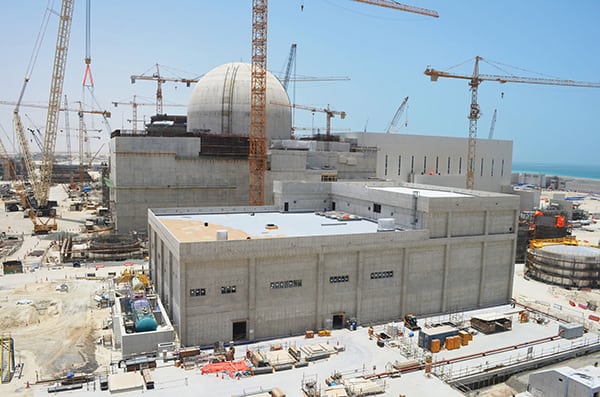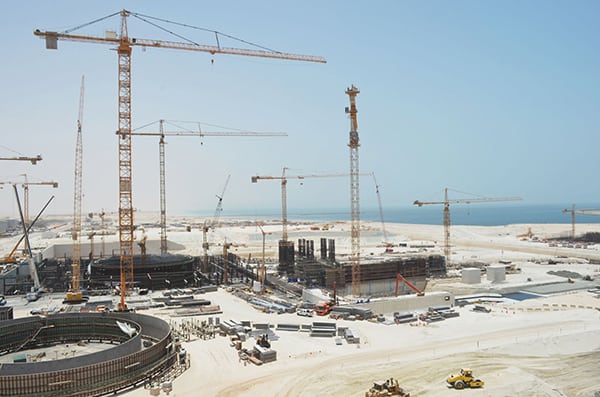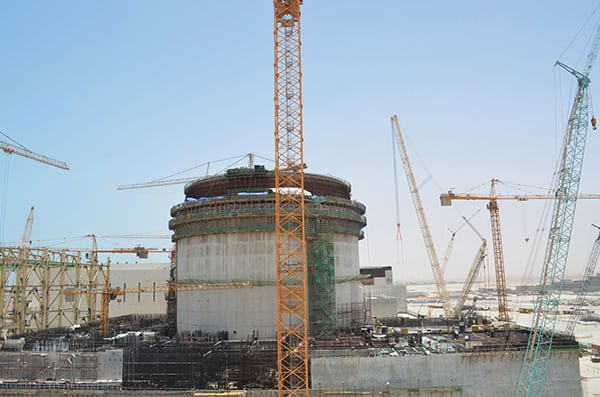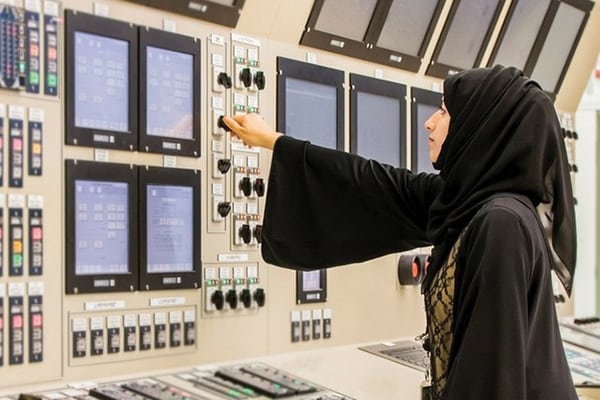Oil- and Gas-Rich UAE Banks on Nuclear Power
The United Arab Emirates (UAE) is a country flush with fossil fuels, so why does its government want nuclear power to form the backbone of its electricity supply? POWER interviewed Emirates Nuclear Energy Corp. CEO Mohamed Al Hammadi to find the answer and to learn more about the world's largest in-progress nuclear construction project.
Located in the southeastern region of the Arabian Peninsula, the United Arab Emirates (UAE) is a country about the size of South Carolina with a population of roughly 9.4 million people. Its coastlines form the south and southeastern shores of the Persian Gulf and part of the western shore of the Gulf of Oman, and its land borders with Oman and Saudi Arabia.
According to the U.S. Energy Information Administration, the UAE is currently the sixth-largest petroleum producer in the world and holds the seventh-largest proved reserves of natural gas. Most of the country's electricity is generated using natural gas, but as demand grows, other resources are beginning to gain traction.
There are plans for nearly 10 GW of capacity to be added in the UAE by 2021. Some will come from renewables; leaders have committed to producing at least 7% of the nation's total power generation from renewable sources by 2020. Some coal-fired generation is also being added; the first phase (two 600-MW units) of a 3,600-MW ultrasupercritical facility is expected to begin operating in Dubai within five years. But the largest addition to the mix is expected to be four Advanced Power Reactor (APR) 1400 nuclear units currently under construction at the Barakah site (Figure 1) in the western region of the Emirate of Abu Dhabi.
 |
1. Nuclear oasis. The first unit at the Barakah Nuclear Power Plant in the United Arab Emirates is expected to begin operation in 2017. Courtesy: Emirates Nuclear Energy Corp. |
POWER interviewed Emirates Nuclear Energy Corp. (ENEC) CEO Mohamed Al Hammadi to learn more about the Barakah project. He talked about some of the challenges that his company has faced, developing not only a 5.6-GW facility but also an entirely new industry for his country. Some of Mr. Al Hammadi's responses have been edited for style and length.
POWER: Countries such as Germany and Switzerland are phasing nuclear power out of their energy mixes, yet the UAE is pushing forward with the energy source. Why is nuclear power attractive to you?
Mohamed Al Hammadi: Every country has a unique set of requirements and characteristics that determine its energy portfolio. Energy policymakers use these requirements to compose the most appropriate energy portfolio to provide safe, reliable, and commercially competitive electricity to power their growth. In the UAE, the government has made a decisive commitment to provide a more sustainable and long-term-oriented electricity sector that can preserve its natural energy resources and provide higher quotas of energy security and energy diversification.
In order to select the best energy technologies to power growth, in 2007 the UAE conducted an extensive study into the country's growing energy demand and electricity generation capacity. The study found that existing and planned electricity supply would not meet future demand, and that by 2020, peak energy demand will grow to more than 40,000 MW-a rate of 9% per year, which is three times the global average. In 2008, the year before we announced our peaceful nuclear energy program, the UAE's electrical load was 15.5 GW, supplied almost exclusively by natural gas (98%). After reviewing multiple energy technologies, it was concluded that nuclear energy was the right choice for the UAE because it is a safe, clean, and proven technology; is commercially viable; and delivers significant volumes of baseload electricity with nearly zero carbon emissions.
Fossil fuels continue to provide important contributions to our electricity generation capacity, but the UAE has made a strategic decision to diversify its energy portfolio and to increase energy security margins with the introduction of clean energy for the benefit of future generations. Nuclear energy, along with renewables, compose the backbone of the future of electricity in the UAE and together will provide more than 30% of the nation's energy by 2020 while increasing its energy security and diversifying its energy portfolio. With that in mind, ENEC has been tasked with the mission of delivering safe, clean, efficient, and reliable nuclear energy to the UAE grid by 2017.
Korea Electric Power Corp. (KEPCO) is the prime contractor for the four reactors being installed at the Barakah site. How did ENEC make the decision to utilize the APR1400 design?
Al Hammadi: KEPCO is a valuable partner in the development of our nuclear energy program. They bring significant knowledge and expertise to the project that complements our project management expertise. These elements have been crucial to achieve every major milestone of the UAE peaceful nuclear energy program since construction began in Barakah and in adherence to the highest standards of safety and quality. This is a testament to the expertise and dedication of the team working on this project.
Our prime contractor was selected after a thorough yearlong selection process, which was designed to identify the best long-term partner for the UAE. The process was guided by the Policy of the United Arab Emirates on the Evaluation and Potential Development of Peaceful Nuclear Energy, which set strict standards for safety and security, nonproliferation, and sustainability.
A team of more than 75 dedicated experts evaluated the bids for the UAE's first nuclear energy plants. Collectively, the team boasted more than 900 years of directly relevant experience in the nuclear industry. The team was made up of experts in nuclear energy plant safety, design, and construction; operations and maintenance; nuclear quality assurance, supply chain management, and procurement; nuclear fuel management; siting analysis (including environmental impact assessment, seismology, geology, meteorology, and hydrology); finance (including generation cost modeling and project finance); legal and contracting; program management; utility operations; and communications and community relations.
The comprehensive bidding process selected the Korean consortium, as their proposal met the conditions set forward by the UAE in terms of technology, adherence to the highest standards of safety and quality, commercial competitiveness, knowledge transfer, and operational readiness.
What are the most challenging aspects of building a nuclear plant in the UAE? Has the APR1400 design required modification to accommodate for these challenges?
Al Hammadi: Anywhere in the world, nuclear energy facility construction is a significant undertaking and must meet exacting standards of safety, quality, and documentation. In building such a significant facility in the unique UAE climate, we needed to ensure its long-term sustainability while minimizing any impacts on the environment.
Since the initial design and planning phases, we have put a special emphasis on making the plant compatible with the local climate. To achieve this, we have used international operating experience, as well as the UAE's unique expertise in constructing and operating large-scale energy projects in these conditions. To that end, and in line with the requirements set forward by our nuclear and environmental regulators, we needed to make a number of adaptations to the design. These changes specifically address the higher temperatures, drier air, and high volumes of airborne sand and dust. These include:
a- Installing larger pumps, heat exchangers, and pipes to increase the water flow rate of the cooling systems to deal with the higher seawater temperatures in the Gulf.
a- Constructing a modified breakwater to ensure that the discharge and intake structures are at an increased distance from each other to avoid recirculation of warmer water.
a- Designing the seawater intake and plant cooling systems to ensure compliance with the Environmental Agency-Abu Dhabi (EAD) standards for changes in Gulf water temperature near the plants.
a- Adding more ventilation and air conditioning to counter the effects of higher temperatures, drier air, and high volumes of airborne sand and dust.
a- Developing a refined intake screen design to help protect local fish populations during operations.
The Barakah water circulation system has some unique design characteristics. How did the innovations come about?
Al Hammadi: Our team worked with KEPCO to adapt the plant design so that it would operate safely and reliably in the UAE's unique climate. The water circulation system is designed to recycle water in perpetual loops in order to minimize water usage, contain contaminated water, and prohibit the introduction of excess heat to nearby bodies of water. ENEC has pioneered this system to protect the local environment and conserve the UAE's natural resources.
The first unit at Barakah is projected to be complete on May 1, 2017, with another new unit being added each year through 2020. Is the project on schedule?
Al Hammadi: I am proud to say that we have met every major milestone since we began construction. We recently safely delivered a major milestone for the program, commencing safety-related construction of Unit 4. This achievement has positioned our site, Barakah, as a leading nuclear energy project and the only site that is presently constructing four identical nuclear reactors simultaneously.
As of mid-October, Unit 1 was 76.9% complete and Unit 2 was 55% complete. Units 3 and 4 were 33.9% and 19.3% complete, respectively. This is a remarkable achievement for a project as vast and sophisticated as the UAE nuclear energy program. The evolution of our site has been spectacular (Figure 2), but it is the result of hard work and focus from all the stakeholders involved in the project.
 |
2. A sea of activity. With four units under construction simultaneously, a bevy of cranes are in constant motion throughout the site. Courtesy: Emirates Nuclear Energy Corp. |
What have been the most difficult tasks completed to date?
Al Hammadi: In the area of operational readiness, we completed in 2015 another crucial milestone when we filed the Operating License Application (OLA) for Barakah Units 1 and 2 with the UAE's Federal Authority for Nuclear Regulation (FANR). The OLA is approximately 15,000 pages and took a team of ENEC and KEPCO employees, along with a number of international experts, five years to complete. The application documents the plant's adherence to the highest standards of safety, quality, and security.
As we planned for the development of the UAE's peaceful nuclear energy program, one of the challenges we experienced was the need to create a nuclear industry here in the UAE to support the construction and operations of the plants in Barakah. In order to achieve this, ENEC and KEPCO have worked with UAE companies to develop a new industrial sector to support the nation's economic growth and diversification strategy. This is a project that we have been working on since the inception of the program in 2009, and it is starting to produce positive results.
We created a dedicated industrial development team to work alongside UAE companies to raise their standards to meet the unique requirements of the nuclear industry. This has allowed these companies to not only contribute to the success of the ENEC program but also to gain a competitive advantage in providing nuclear-quality services and materials to the world.
ENEC works with local companies to upgrade their systems to become ASME nuclear component-certified companies, the key certification required to become nuclear-approved suppliers. ENEC and KEPCO also hold regular supplier forums to ensure local companies are informed about upcoming opportunities and are educated on the steps required to register for the tendering process for Barakah projects. We have worked with companies such as Emirates Steel, National Cement, Dubai Cable Co. (DUCAB), National Marine Dredging Co., Western Bainoona Group, and Hilalco to bring them into the nuclear-certified category, and to provide products and services to our program and the world.
Recently, we achieved a key milestone by awarding more than $2.5 billion in local contracts in just the first few years of construction at Barakah. With 40 years of operations ahead for each of our units, there will be many more opportunities for UAE businesses that are committed to instilling nuclear safety and quality standards across their organization. Through its work with local companies, ENEC is not only supporting existing businesses in the UAE but also contributing to the development of the local economy while stimulating the growth of its local industry.
How many workers do you currently have on site? Where have most of the workers come from? What resources have been utilized to train workers?
Al Hammadi: More than 18,000 people are safely delivering the Barakah project. From the pouring of the first safety-related concrete for Unit 1 in 2012 until mid-October 2015, approximately 63 million man-hours have been invested in the construction of the Barakah units. This is almost three times the number of man-hours required to complete construction of the Burj Khalifa (the tallest building in the world-standing 2,716.5 feet-located in Dubai). We are simultaneously constructing four APR1400 reactors and therefore are expecting the number of staff in Barakah to continue until the delivery of Unit 1.
To ensure that safety is the overriding priority in Barakah, we have hosted more than 7,500 dedicated safety trainings since the beginning of the program, attended by nearly 250,000 people. In addition to utilizing a talented construction workforce, we're also focused on building a highly skilled Emirati-led team to meet the needs of this growing new industry (see sidebar).
ENEC developed the Energy Pioneers program to attract and to develop the country's most talented science students, engineering graduates, and experienced professionals. Since the Energy Pioneers program started in 2009, nearly 400 young Emiratis have become part of the ENEC scholarship program and have begun their careers in this dynamic new industry. In total, over approximately five years, we have grown into a team of more than 1,200 people, with more than 60% of our ENEC staff composed of talented Emiratis. By 2020, ENEC will need approximately 2,500 employees.
What environmental aspects have been the most challenging?
Al Hammadi: Working with KEPCO and under the regulations of FANR and the EAD, we have made enhancements to the design of the plants to ensure the plant operates safely in the UAE's climate. It is important to mention that the UAE has unique know-how and expertise in plant cooling, thanks to the prior work of energy companies and the safe operation of large-scale energy projects in the UAE.
All modifications have been subject to the thorough scrutiny of our regulators, FANR and the EAD, which approved these modifications as part of the Environmental Impact Assessment and the Construction License Applications.
What are you most proud of at this point in the construction process?
Al Hammadi: I am proud that we have met every major milestone since construction began in Barakah. We have managed to achieve this by creating a multinational and multidisciplinary team that focuses on the changing priorities and goals of the program.
Today, we are focused on the delivery of three strategic goals. They are:
a- Guarantee project delivery, which involves the safe and quality-focused delivery of the Barakah Nuclear Power Plant.
a- Ensure operational readiness, which focuses on preparing for operations.
a- Support and develop capability, which includes promoting a strong performance management culture based on continuous improvement.
Our team is dedicated to the delivery of the UAE peaceful nuclear energy program in strict adherence to the highest safety and quality standards, and that has been apparent throughout this entire process. We benefit from exceptional levels of international nuclear industry collaboration, along with the most qualified and talented Emirati experts, and this has been an important addition to our construction expertise. Moving forward, we remain focused on operational transparency and excellence, with the goal of safely delivering and operating four nuclear energy units by 2020.
Do you think your team can avoid delays and cost overruns, which have plagued nuclear construction projects in other parts of the world?
Al Hammadi: The development of the UAE's nuclear energy program is one of the most ambitious and strategic projects undertaken in the country in the last 40 years. Our priority has always been to develop the program in adherence to the highest standards of safety and quality, as well as to align to the commitments made by the UAE as part of the Policy of the United Arab Emirates on the Evaluation and Potential Development of Peaceful Nuclear Energy.
Our project management capability and the expertise provided by the Korean consortium have enabled us to safely achieve all the project milestones so far and to achieve them on time. We are solely focused on the delivery of our Barakah project (Figure 4) and we will continue to ensure that safety is the overriding priority of the program.
 |
4. Containing the risk.The reactor containment, shown under construction, will house one of the APR1400 pressurized-water reactors with its two steam generators, four reactor coolant pumps, and various other associated primary components. Courtesy: Emirates Nuclear Energy Corp. |
Has there been much concern voiced by the local population about the risks associated with nuclear power?
Al Hammadi: Since the beginning of the UAE's nuclear energy program, we've been committed to public engagement and keeping the community informed. We have established a dialogue with the UAE population to increase the understanding of nuclear energy. One of the many initiatives we have launched is the public forum where community leaders and the public learn about nuclear energy. In the forums, attendees raise any issues on nuclear energy and ask any questions. The leadership of ENEC heads these forums and has welcomed more than 6,500 people so far. The forums give us a unique opportunity to engage with the community directly and in a transparent manner, and we believe this has produced positive results in the support for nuclear energy.
Another key tool to support our community engagement has been that ENEC has created a new tone to communicate on nuclear energy issues. We are very open in addressing any negative preconceptions associated with nuclear energy and respond to them using scientific data explained in a user-friendly manner.
For example, we explain the issue of spent fuel by using scientific data and comparing it to the waste generated by other energy sources and the levelized costs of energy generation. We explain what happened in Fukushima and provide clear information on why our technology is equipped to respond to a station blackout scenario in a safe and controlled manner, and why Barakah is a seismically stable area that will not be subject to major earthquakes or tsunamis. People welcome this honest discussion and user-friendly explanations, and it is reflected in the high levels of support for nuclear energy in the UAE.
In order to measure our community engagement and stakeholder communication, we commission several independent surveys in the form of public opinion polls to stay informed on issues and concerns that may arise in the community. These surveys have shown an increase in public support for the project. In December 2012, 82% of people surveyed in the UAE were in favor of nuclear energy. This is compared to 66% in 2011. Further, 89% of those surveyed supported a plant being built in the UAE, an increase from 67% in 2011, before construction started in Barakah.
The 2012 survey also found that awareness of nuclear energy had increased. A total of 89% of residents felt that peaceful nuclear energy is "extremely important," "very important," or "important" for the UAE. In addition, 55% viewed it as a main source of power generation, second to oil. This high level of support was attributed to robust public engagement efforts.
What does the future hold for the UAE's nuclear industry?
Al Hammadi: Our nuclear energy program is a significant and long-term investment that will provide safe, clean electricity with nearly zero carbon emissions. ENEC's vision is to power the future growth and prosperity of the UAE through a safe and sustainable peaceful nuclear energy program. With recent milestones, such as the submittal of our OLA to FANR and the start of concrete work on Unit 4, we are continuing on our journey to deliver four nuclear energy units by 2020 and operate the plants in adherence to the highest standards of safety and quality. a-
-Aaron Larson is a POWER associate editor.
The post Oil- and Gas-Rich UAE Banks on Nuclear Power appeared first on POWER Magazine.
